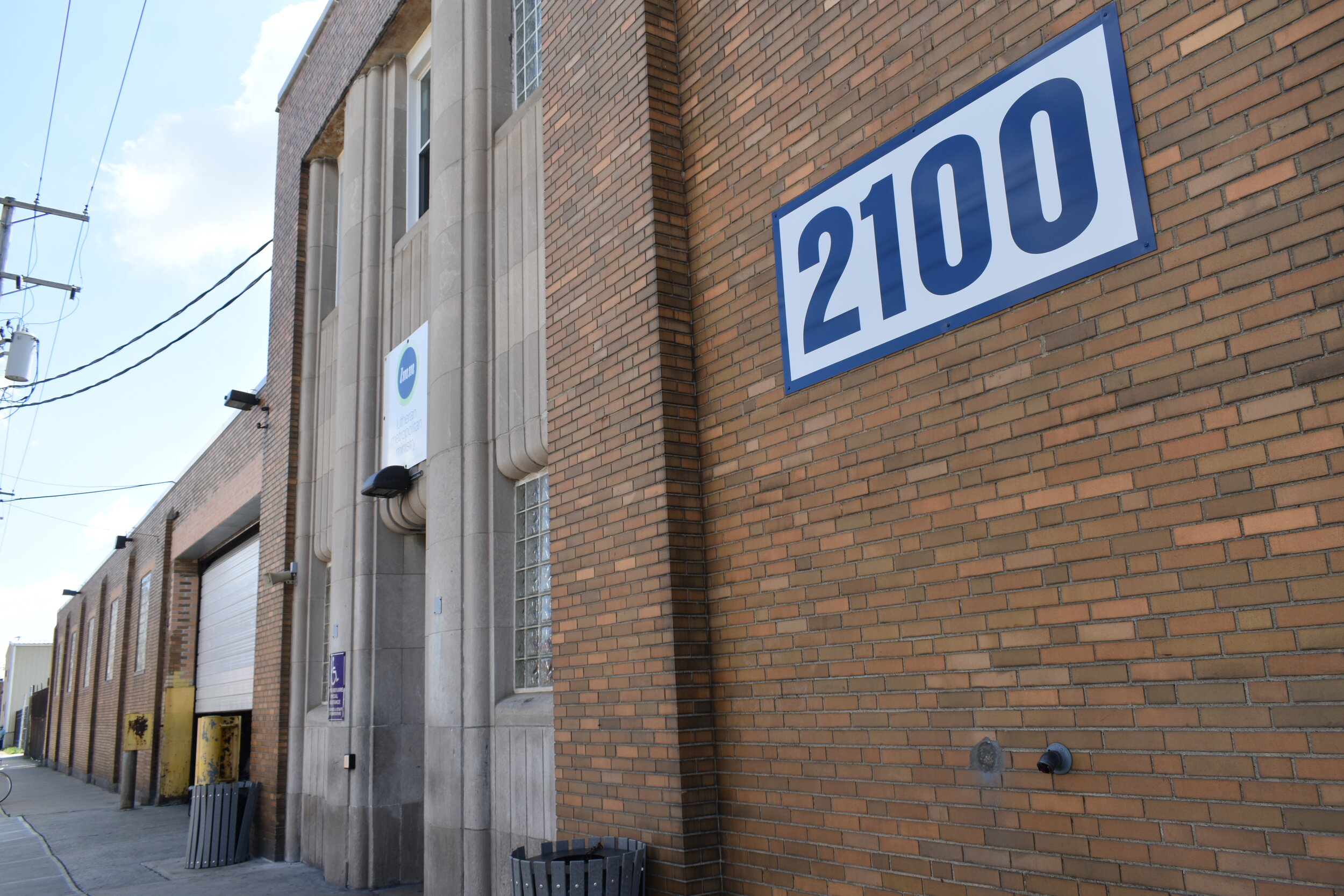NE Ohio shelters put measures in place to protect residents; how effective are they?
by: Conor Morris
This story is sponsored by the Northeast Ohio Solutions Journalism Collaborative, which is composed of 16-plus Greater Cleveland news outlets including The Cleveland Street Chronicle
Photo by Conor Morris
It’s a hot Friday morning at 2100 Lakeside Avenue as director of operations David Blunt walks out into the yard of the homeless shelter for men in central Cleveland.
He eyes some residents hanging out at a table, watching TV and talking, noticing something quickly.
“Hey fellas, put those masks on… put those masks on, gentlemen!” Blunt hollers.
Blunt said there’s plenty of things the shelter, run by the Lutheran Metropolitan Ministry, has done to keep its residents safe during the COVID-19 pandemic: Mandatory temperature checks at the door; mandatory mask wearing (residents are given a mask if they don’t have one); removing the top bunks from the beds in the shelter’s congregant-living area, and reducing the shelter’s capacity of roughly 400 beds by half. Instead, some of the residents have been moved to hotels in the area.
But there’s one key piece that was missing in the beginning of the pandemic, back in March: Access to COVID-19 testing to make sure that the dangerous disease doesn’t endanger the lives of the homeless staying in shelters.
Recognizing that major gap, in early May, workers with MetroHealth Systems – in partnership with the Cuyahoga County Board of Health – tested almost 1,100 people living and working in homeless and other shelters in the Cleveland area for COVID-19.
As of late July, they found that 33 people were positive for COVID-19 through that effort (about three percent), according to MetroHealth spokesperson Dorsena Drakeford.
Compare these findings to a federal Centers for Disease Control study of homeless shelters in Boston, for example, where roughly 36 percent of homeless shelter residents and 30 percent of staff tested positive for COVID-19 at one point in time back in early April.
The low number of positive cases at the local shelters speaks partly to efforts to de-populate those shelters, according to Dr. Michael Seidman with MetroHealth. As mentioned above, residents at shelters across the Cleveland area have been placed into hotels in order to allow for more social distancing.
Recently, the number of hotels used for that purpose has increased from two to four, according to a statement from the Northeast Ohio Coalition for the Homeless (NEOCH).
Dr. Seidman, an assistant professor with the Case Western Reserve University School of Medicine, led a team with MetroHealth in partnership with Cuyahoga County to provide the mass-testing to staff and residents at the various homeless- and congregant-living shelters around Cleveland, as well as to some non-shelter locations like homeless camps.
Seidman said that effort is important because these are groups of people who don’t have health insurance, don’t have easy access to health-care in general, and don’t necessarily have the most up-to-date information on the COVID-19.
“One of the main things that we’ve done when our team has gone out to either screen or test is to be able to, face-to-face, answer some questions to the best of our ability, both shelter staff and clients,” Seidman said. “You know a lot of those folks don’t have phones… so the information you get is sporadic and maybe contradictory.”
Michael Sering, VP of housing and shelter with Lutheran Metropolitan Ministries, said that partnership with MetroHealth is very important for the safety of shelter residents. It’s evolved to the point that anybody new in the shelter is required to be tested, as well.
“They were able to test everybody at the shelter, so we were able to do one big mass testing just to get started,” Sering said. “And then now they come a couple times a week and they test any of the people who are new to the shelter. What we do is, within the shelter itself, we… have separate areas so when we have new people they would be designated to one area until they’ve been tested.”
David Blunt, director of operations at Lutheran Metropolitan Ministry’s men’s shelter, sits at his desk at the homeless shelter at 2100 Lakeside Avenue in Cleveland. Photo by Conor Morris
What about other shelters?
Beau Hill, executive director of the Harbor Light complex with the Salvation Army of Greater Cleveland, said the Salvation Army’s two shelters, one for men and one for families, also had a significant portion of their residents and staff tested for COVID-19 through the MetroHealth/County Board of Health effort. Hill said the Salvation Army’s shelters do help residents get tested for COVID-19, and strongly recommend their residents wear masks but they aren’t requiring new residents to be tested or to wear a mask.
“If we make it a hard and fast rule that you’d have to wear (a mask), we’d eventually have to kick people out,” he said. “Do you want to kick homeless people out of a shelter because they’re not wearing a mask? That doesn’t make any sense.”
Sering, with LMM, said that his shelter has successfully gotten residents to comply with both mandates, and said the shelter has a system of “sanctions” if residents don’t comply, which stop short of kicking people out.
Bobby Watts, CEO of the nonprofit National Health Care for the Homeless Council, said there are several constants that all congregant-living shelters should be doing during the pandemic. The big three? Requiring residents to wear masks; spacing residents out; and cleaning constantly.
“The term that’s come into use is to ‘decompress’ areas,” Watts explained. “Decompress the cafeteria, the same with classrooms… basically, limit the amount of people that can be in there at one time. Some missions (shelters) have… chapel service and instead of having everyone in the chapel at once, they may broadcast it to various parts of the building.”
Watts said that it’s good that some shelters are providing regular COVID-19 testing for their residents, but, the lag time for getting results back, and the variability of supply and access to testing, means that shelters should not be requiring a negative COVID test before admitting people (neither 2100 nor the Salvation Army do this, however).
Enough room to (safely) accommodate everyone?
Hill and Sering both said the pandemic has presented a host of difficulties for homeless shelters, even as the need for their services has increased. Hill said the Salvation Army has depopulated its shelters a little (from about 450-475 across all of the Salvation Army of Greater Cleveland’s residential programs down to about 350-400) in an attempt to increase social distancing for residents. But, that comes with a big negative: less government funding, which matches the number of residents being served. Less revenue means less ability to serve an already-vulnerable population of people during the pandemic, Hill said. Hill did say that the structure of the residential areas of the family shelter does naturally lend to social distancing, with families in separate living units, however.
Between the beginning of the pandemic and early July, the Salvation Army had 15 staff and roughly 25 residents who tested positive (out of facilities with 145 staff and around 215 residents). Sering, with LMM, declined to say how many residents and staff had tested positive. But, he said his shelter’s ratio of positive cases has been close to the 3 percent number cited by MetroHealth earlier in this story (the U.S.’s daily positive case rate was around 6.75 percent as of the end of July).
One of the challenges, Hill said, is that there’s a lot of misinformation out there about COVID-19, and homeless people don’t necessarily have the tools to combat that misinformation. Christopher Knestrick, executive director of NEOCH, said the pandemic has meant closure of some public spaces, including places where homeless people would typically go to access power to charge a phone or get free WiFi.
To combat that, NEOCH’s Outreach Collaborative has tried to engage with “as many people on the streets as possible,” including checking in with people through its East Side and West Side Homeless Congress groups, he said. Outreach workers with that collaborative can also accompany homeless clients to medical centers like Care Alliance to get tested for COVID-19.
“We are regularly making calls and checking in with people who are staying in shelter or on the streets to communicate important updates (like wearing a mask, how to get tested, which symptoms to watch out for, etc.),” Knestrick said. “’Word on the street’ has always been the most powerful way to spread news and updates to those unhoused in our community, and that can be a real challenge when we want to communicate important information with people who are already vulnerable and struggling to meet basic needs.”
Back at 2100, even with attempts to reduce the number of people in the shelter, there’s difficulty in achieving enough distance to keep residents separated from each other. The beds are “6 feet-ish” apart, said 2100’s David Blunt, in large communal sleeping areas.
A recent study by the Cleveland Institute of Art, which has long had a partnership with Lutheran Metropolitan Ministries, found that in order to achieve an ideal balance of living space with adequate distance, the shelter would need to have a maximum of 120 residents. It’s currently hovering at around 180, Sering said. The shelter is having residents sleep head-to-foot, which is one recommendation from Watts with the National Health Care group, but there’s not enough room to space the bunks out adequately.
It's possible to get the shelter down to that level recommended by the Cleveland Institute of Art, Sering said, but only if there isn’t a “huge rush” of additional people needing shelter. Some experts are predicting a wave of evictions to crash across the country with eviction-moratoriums now expired and much of the support from the federal government running out. If that happens, 2100 may need to bring back its top bunks, Sering said.
But still, there’s hope for a more long-term solution.
“We have continued to work with the county on more people going to hotels,” Sering said. “We also have an initiative with the city as a COVID response… for some of our hard-to-place people, we’re going to be looking at renting apartments that we would manage… we’ve projected to get 75 people out (of 2100) over the next 12 months.”
Conor Morris is a corps member with Report for America. You can find him on Twitter at @condormorris, or email him at cmorris@advance-ohio.com. This story is sponsored by the Northeast Ohio Solutions Journalism Collaborative, which is composed of 16-plus Greater Cleveland news outlets including The Cleveland Street Chronicle.


